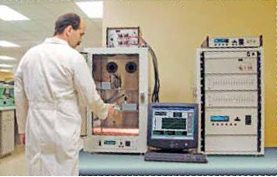Calibration always seems to be scheduled at the most critical time in a project, but is it really important? This article explains briefly what true calibration is, why it is necessary, and how often it should be performed. The article also discusses how to ensure accurate calibration when working with a metrology lab
Bill Laumeister
Calibration always seems to be scheduled at the most critical time in a project—for instance, when the team is working round-the-clock to prepare for an annual industry trade show. As an example of how calibration can affect a project, let us assume that a piece of test equipment is on a six-month calibration cycle. At month five, the design engineer starts a test sequence that lasts two months. If the instrument is recalibrated in the middle of the test, the drift or errors that built up in the first five months can be significant enough to require that the tests be redone. Wouldn’t it be better to calibrate instruments before starting on a big project requiring that equipment? And wouldn’t it be nice if the calibration schedule was posted so there are no surprises? One should schedule calibration in the project planning software, just like any other event, as it may be on a critical path. If it is ignored, calibration can delay the project.

What is calibration?
Some people check two instruments (for example, scopes and meters) and consider them ‘calibrated’ if they give the same reading. However, there are some issues with this approach, the least of which is that it is totally unscientific. To compare the logic, no one would allow a book-keeper to audit his or her own work. When performing calibration in this way, there are three obvious conditions that are impossible to decipher. First, when one instrument is right and one is wrong, which is which? Second, if both instruments are wrong in opposite directions, how can an engineer tell that neither result is correct? And finally, when both instruments are wrong in the same way, an engineer has a bad result and won’t even know. One cannot tell when an instrument is correct without a true traceable external standard.
The calibration standard must always be significantly more accurate than the instrument under test. Don’t forget that the standard also has a tolerance. If the tolerance band of the device under test (DUT) and the tolerance band of the standard overlap, there isn’t a clear calibration. That is why calibration typically requires a standard that has at least 10x the accuracy of the DUT. Having a standard with clear, small tolerances allows the DUT to be adjusted, preventing it from giving an out-of-specification reading as it experiences normal drift between calibrations. When calibrating state-of-the-art instruments, it is impossible for the standard to be 10x better. As a practical matter, a standard that is 4x more accurate can be used, but only in conjunction with more complex procedures, which include cross-checks with other standards.
Metrology labs
Serious engineers buy top instrument brands and expect those electronic test instruments to be accurate. Over time, things drift; so these engineers send their instruments to a metrology lab for calibration. But what really happens at the metrology lab?
The majority of metrology labs are good and effective. Unfortunately, there are exceptions. Some companies look for the lab that is the lowest bidder without studying other qualifications. It is up to engineers to verify the veracity of the lab. A great lab will be happy to show you around and will be proud of the traceability of its standards. Take the calibration manual for your instrument and sit with the lab personnel. Verify that the lab has the necessary instruments to perform accurate calibration.
You must also ensure that a lab’s instruments are properly calibrated with traceability. Most countries have their own national standards laboratory for this; in the US, it is the National Institute of Standards and Technology (NIST). A good metrology lab has records showing that its instruments compare correctly to a chain of standards that go back to a master standard maintained by the NIST or other national standard.
Internal components of test instruments (such as voltage references, input dividers, amplifier gain and offset) can drift over time. A good calibration schedule ensures that the typically minor drift does not impair the measurement. It is this drifting that calibration finds and corrects. But accidents do happen; instruments can be dropped or one can slip and probe a high voltage. For example, a digital multimeter (DMM) can be overloaded, causing a large error. Some mistakenly think that this does not produce an out of calibration error as the inputs are fused or breaker protected. However, a high voltage can jump across the input-protection device, or a transient can destroy the circuit before the protective device has time to react.





